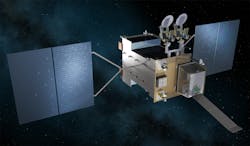Lockheed Martin to build next-generation infrared surveillance sensors for space-based missile-defense
LOS ANGELES AFB, Calif. – Surveillance satellite designers at Lockheed Martin Corp. will build three new next-generation infrared spacecraft to help detect enemy ballistic missile launches under terms of a $4.9 billion order announced Monday.
Officials of the U.S. Space Force Space and Missile Systems Center at Los Angeles Air Force Base, Calif., are asking the Lockheed Martin Space Systems segment in Sunnyvale, Calif., to build three Next Generation Geosynchronous (NGG) satellites and ground sensor-processing software.
NGG are the latest geosynchronous satellites and infrared sensors that are part of the U.S. Space Force’s Next Generation Overhead Persistent Infrared (Next-Gen OPIR) satellite constellation -- an extension of the Space Force's Space-Based Infrared System (SBIRS).
In addition to Lockheed Martin, the Northrop Grumman Corp. Aeronautics Systems segment in Redondo Beach, Calif., is building two polar-orbiting infrared surveillance satellites of the Next-Gen OPIR system -- called the Next-Generation Polar (NGP) project. Northrop Grumman won a $2.4 billion order last May to build the two NGP satellites.
This week's order to Lockheed Martin includes engineering support for launch vehicle integration and launch, and early on-orbit checkout for all three NGG satellites.
The SBIRS program is to provide enhanced strategic and theater ballistic missile warning capabilities. The first two SBIRS geosynchronous satellites started operating in 2013. The planned seventh and eighth SBIRS satellites have been switched to the new Next Gen OPIR program.
Compared to SBIRS, the NGG satellites reportedly offer improved missile warning capabilities that are more survivable against emerging threats. The first NGG satellite is to launch in 2023.
Building the infrared surveillance sensor payloads for the NGG satellites are the Raytheon Technologies Corp. Intelligence & Space segment in Arlington, Texas; and a team of Northrop Grumman Aeronautical Systems and Ball Aerospace.
On this week's order Lockheed Martin will do the work in Sunnyvale, Calif., and should be finished by May 2028. For more information contact Lockheed Martin Space Systems online at www.lockheedmartin.com, or the Space Force Space and Missile Systems Center at www.losangeles.spaceforce.mil.
About the Author
John Keller
Editor-in-Chief
John Keller is the Editor-in-Chief, Military & Aerospace Electronics Magazine--provides extensive coverage and analysis of enabling electronics and optoelectronic technologies in military, space and commercial aviation applications. John has been a member of the Military & Aerospace Electronics staff since 1989 and chief editor since 1995.
